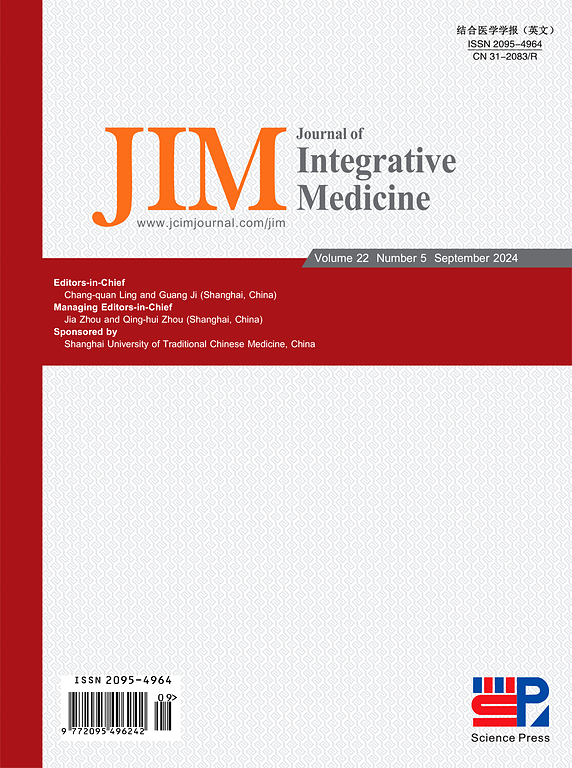膝关节骨关节炎患者穴位热致敏:一项横断面病例对照研究。
IF 4
2区 医学
Q1 INTEGRATIVE & COMPLEMENTARY MEDICINE
引用次数: 0
摘要
目的:不同的穴位选择代表了针灸治疗膝骨关节炎(OA)疗效不确定的潜在原因。皮肤温度是穴位选择的一个指导因素,可能有助于解决这个问题。本研究探讨热致敏穴位用于治疗膝关节OA。方法:本横断面病例对照研究纳入年龄45-75岁的症状性膝关节OA患者和年龄和性别匹配的非膝关节OA对照组,比例为1:1。所有的参与者都进行了红外热成像。主要观察指标为穴位相对皮肤温度(STA),次要观察指标为11个穴位的绝对皮肤温度。采用z检验比较各组间的相对sta和绝对sta。采用主成分分析提取sta的共同因子(CFs,腧穴聚类)。采用一般线性模型确定影响膝关节OA患者STA的因素。相对STA组间比较,P < 0.0045(经11个穴位Bonferroni校正)为有统计学意义。其他分析以P < 0.05为具有统计学意义的阈值。结果:共纳入308例患者,其中151例(平均年龄:[64.58±6.67]岁;男:25.83%;平均体重指数:[25.70±3.16]kg/m2),对照组157人(平均年龄:[63.37±5.96]岁;男:26.11%;平均体重指数:[24.47±2.84]kg/m2)。膝关节OA组ST34 (P = 0.0001)、EX-LE2 (P < 0.0001)、EX-LE5 (P = 0.0006)、SP10 (P < 0.0001)、BL40 (P = 0.0012)、GB39 (P = 0.0037)的相对sta均较高。ST35、ST36、SP9、GB33、GB34的STAs差异无统计学意义。两组均有4例CFs为相对STA。各组间CF内穴位一致。膝关节OA组各CF的相对sta平均值较高。在膝关节OA病例中,没有观察到影响相对STA的因素,而发现年龄和性别影响绝对STA。结论:膝关节OA患者的热致敏发生在下肢的穴位,表现出局部和区域性的热一致性。我们在本研究中确定的热致敏穴位ST34、SP10、EX-LE2、EX-LE5、GB39和BL40可能是针刺治疗膝关节OA的良好选择。本文署名:涂建峰,王晓忠,闫思义,王彦,杨建伟,石广新,张文忠,景琳,杨立林,刘德辉,王立强,米波波。膝关节骨关节炎患者穴位热致敏:一项横断面病例对照研究。集成医学[J];打印前Epub。本文章由计算机程序翻译,如有差异,请以英文原文为准。
Thermal sensitization of acupoints in patients with knee osteoarthritis: A cross-sectional case-control study
Objective
Varied acupoint selections represent a potential cause of the uncertainty surrounding the efficacy of acupuncture for knee osteoarthritis (OA). Skin temperature, a guiding factor for acupoint selection, may help to address this issue. This study explored thermal sensitization of acupoints used for the treatment of knee OA.
Methods
This cross-sectional case-control study enrolled cases aged 45–75 years with symptomatic knee OA and age- and gender-matched non-knee OA controls in a 1:1 ratio. All participants underwent infrared thermographic imaging. The primary outcome was the relative skin temperature of acupoint (STA), and the secondary outcome was the absolute STA of 11 acupoints. The Z test was used to compare the relative and absolute STAs between the groups. Principal component analysis was used to extract the common factors (CFs, acupoint cluster) in the STAs. A general linear model was used to identify factors affecting the STA in the knee OA cases. For the group comparisons of relative STA, P < 0.0045 (adjusted for 11 acupoints through Bonferroni correction) was considered to indicate statistical significance. For other analyses, P < 0.05 was used as the threshold for statistical significance.
Results
The analysis included 308 participants, consisting of 151 cases (mean age: [64.58 ± 6.67] years; male: 25.83%; mean body mass index: [25.70 ± 3.16] kg/m2) and 157 controls (mean age: [63.37 ± 5.96] years; male: 26.11%; mean body mass index: [24.47 ± 2.84] kg/m2). The relative STAs of ST34 (P = 0.0001), EX-LE2 (P < 0.0001), EX-LE5 (P = 0.0006), SP10 (P < 0.0001), BL40 (P = 0.0012) and GB39 (P = 0.0037) were higher in the knee OA group. No difference was found in the STAs of ST35, ST36, SP9, GB33 and GB34. Four CFs were identified for relative STA in both groups. The acupoints within each CF were consistent between the groups. The mean values of the relative STAs across each CF were higher in the knee OA group. In the knee OA cases, no factors were observed to affect the relative STA, while age and gender were found to affect the absolute STA.
Conclusion
Among patients with knee OA, thermal sensitization occurs in the acupoints of the lower extremity, exhibiting localized and regional thermal consistencies. The thermally sensitized acupoints that we identified in this study, ST34, SP10, EX-LE2, EX-LE5, GB39 and BL40, may be good choices for the acupuncture treatment of knee OA.
Please cite this article as: Tu JF, Wang XZ, Yan SY, Wang YR, Yang JW, Shi GX, Zhang WZ, Jing LN, Yang LS, Liu DH, Wang LQ, Mi BH. Thermal sensitization of acupoints in patients with knee osteoarthritis: A cross-sectional case-control study. J Integr Med. 2025; 23(3): 289–296.
求助全文
通过发布文献求助,成功后即可免费获取论文全文。
去求助
来源期刊

Journal of Integrative Medicine-Jim
Medicine-Complementary and Alternative Medicine
CiteScore
9.20
自引率
4.20%
发文量
3319
期刊介绍:
The predecessor of JIM is the Journal of Chinese Integrative Medicine (Zhong Xi Yi Jie He Xue Bao). With this new, English-language publication, we are committed to make JIM an international platform for publishing high-quality papers on complementary and alternative medicine (CAM) and an open forum in which the different professions and international scholarly communities can exchange views, share research and their clinical experience, discuss CAM education, and confer about issues and problems in our various disciplines and in CAM as a whole in order to promote integrative medicine.
JIM is indexed/abstracted in: MEDLINE/PubMed, ScienceDirect, Emerging Sources Citation Index (ESCI), Scopus, Embase, Chemical Abstracts (CA), CAB Abstracts, EBSCO, WPRIM, JST China, Chinese Science Citation Database (CSCD), and China National Knowledge Infrastructure (CNKI).
JIM Editorial Office uses ThomsonReuters ScholarOne Manuscripts as submitting and review system (submission link: http://mc03.manuscriptcentral.com/jcim-en).
JIM is published bimonthly. Manuscripts submitted to JIM should be written in English. Article types include but are not limited to randomized controlled and pragmatic trials, translational and patient-centered effectiveness outcome studies, case series and reports, clinical trial protocols, preclinical and basic science studies, systematic reviews and meta-analyses, papers on methodology and CAM history or education, conference proceedings, editorials, commentaries, short communications, book reviews, and letters to the editor.
Our purpose is to publish a prestigious international journal for studies in integrative medicine. To achieve this aim, we seek to publish high-quality papers on any aspects of integrative medicine, such as acupuncture and traditional Chinese medicine, Ayurveda medicine, herbal medicine, homeopathy, nutrition, chiropractic, mind-body medicine, taichi, qigong, meditation, and any other modalities of CAM; our commitment to international scope ensures that research and progress from all regions of the world are widely covered. These ensure that articles published in JIM have the maximum exposure to the international scholarly community.
JIM can help its authors let their papers reach the widest possible range of readers, and let all those who share an interest in their research field be concerned with their study.
 求助内容:
求助内容: 应助结果提醒方式:
应助结果提醒方式:


